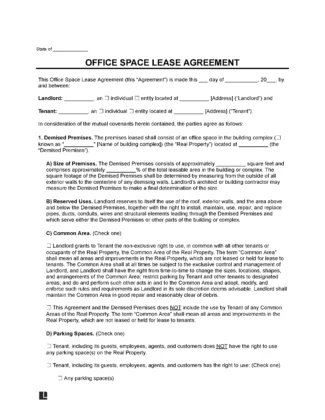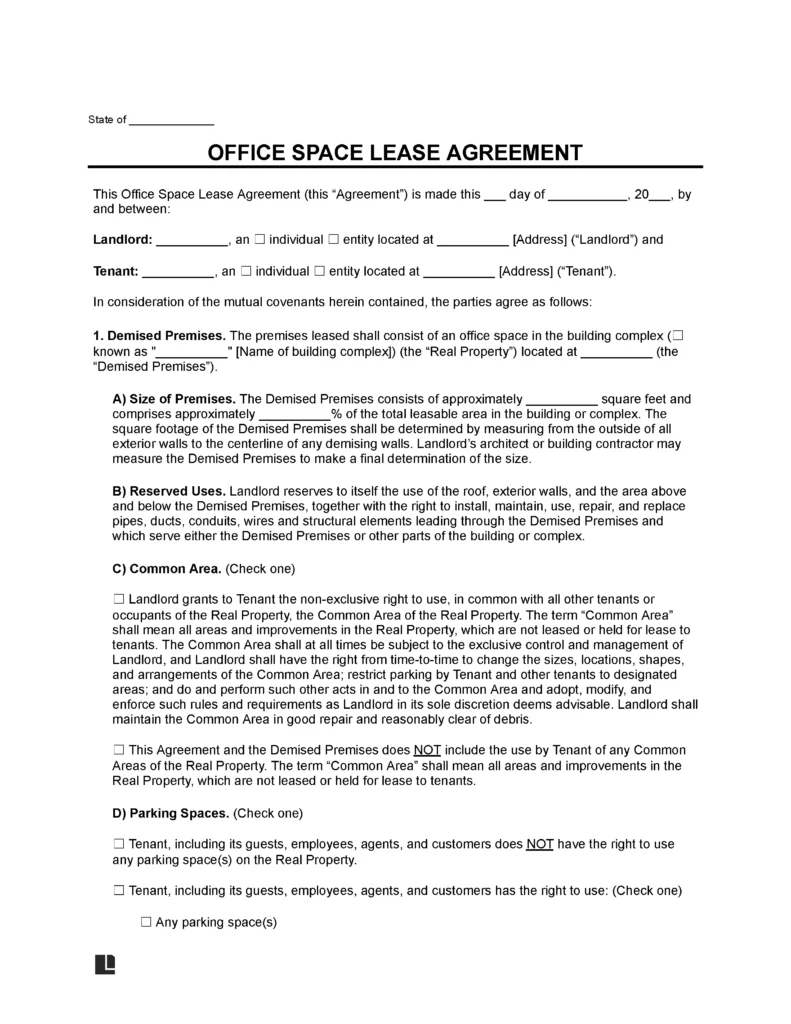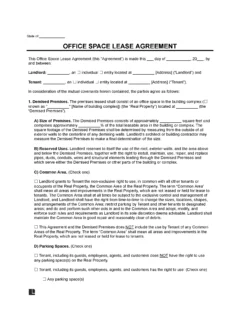
Use our Office Space Lease Agreement template to easily rent out office space to short-term tenants or freelance professionals.

Updated July 16, 2024
Written by Yassin Qanbar | Reviewed by Susan Chai, Esq.
An office space lease agreement is a legal document between a landlord and a tenant outlining the rental of office space, suites, or shared workspaces for office-related use. Rent is typically calculated on a price per square foot ($/SF) and is usually paid monthly, covering amenities, services, and utilities. The agreement details the obligations of both parties.
This agreement is intended for commercial use only and should not be used for retail or residential purposes
Commercial Lease Application Form – Use this form to verify the tenant’s credit history and background.
For Owners or Landlords:
For Prospective Tenants:
Start by exploring online resources such as CommercialSearch, LoopNet, Digsy, Crexi, and OfficeList to find available office spaces for general listings.
These platforms offer flexible lease terms, often allowing cancellation with just 30 days’ notice. Committing to a 6-month or 1-year lease usually results in better rates.
Once you’ve identified potential properties, arrange viewings. During these visits, the landlord or property manager will provide details such as move-in dates, monthly rent, available space, and other specifics.
After selecting the best space, negotiate the lease terms with the landlord. Consider comparing two properties to secure the best rate.
After a verbal agreement, the landlord will verify the tenant’s identity and financial stability using a Rental Application. This process may include checking financial statements and business records, as well as performing credit and background checks.
Tenants with low credit scores often need a lease guarantor to secure their rental agreement. This involves having an individual or entity guarantee the lease.
Below is a detailed list of supplementary documents that may be required:
Once everything is in order, it’s time to sign the lease. There are three ways to do this:
After signing the lease, the tenant will need to pay the security deposit (if applicable) and the first month’s rent. Once these payments are made, the space is ready for occupancy!
Specify the start and end dates of the lease. Typically, leases for smaller spaces (under 2,000 SF) run for 1-2 years, while larger spaces often require 3-5 year commitments.
Tenants may request renewal options at predetermined rent increases, often tied to the Consumer Price Index (CPI).
Rent usually includes a base amount paid monthly and a share of property expenses such as real estate taxes, property insurance, and common area maintenance (CAM) costs. A security deposit, typically one month’s rent, is also common to cover potential lease breaches.
This clause restricts the use of the space to office-related activities, ensuring quiet enjoyment for other tenants. Common restrictions include:
Landlords can deliver the space in three ways:
Landlords often include amenities such as high-speed internet, dedicated parking, 24-hour security, meeting rooms, reception areas, fitness centers, daycare facilities, and on-site food and beverages to attract tenants.
Tenants may be allowed to perform construction but will generally need to revert the space to its original condition if required by the landlord.
Download a template in PDF or MS Word below.


Create Your Office Space Lease Agreement in Minutes!